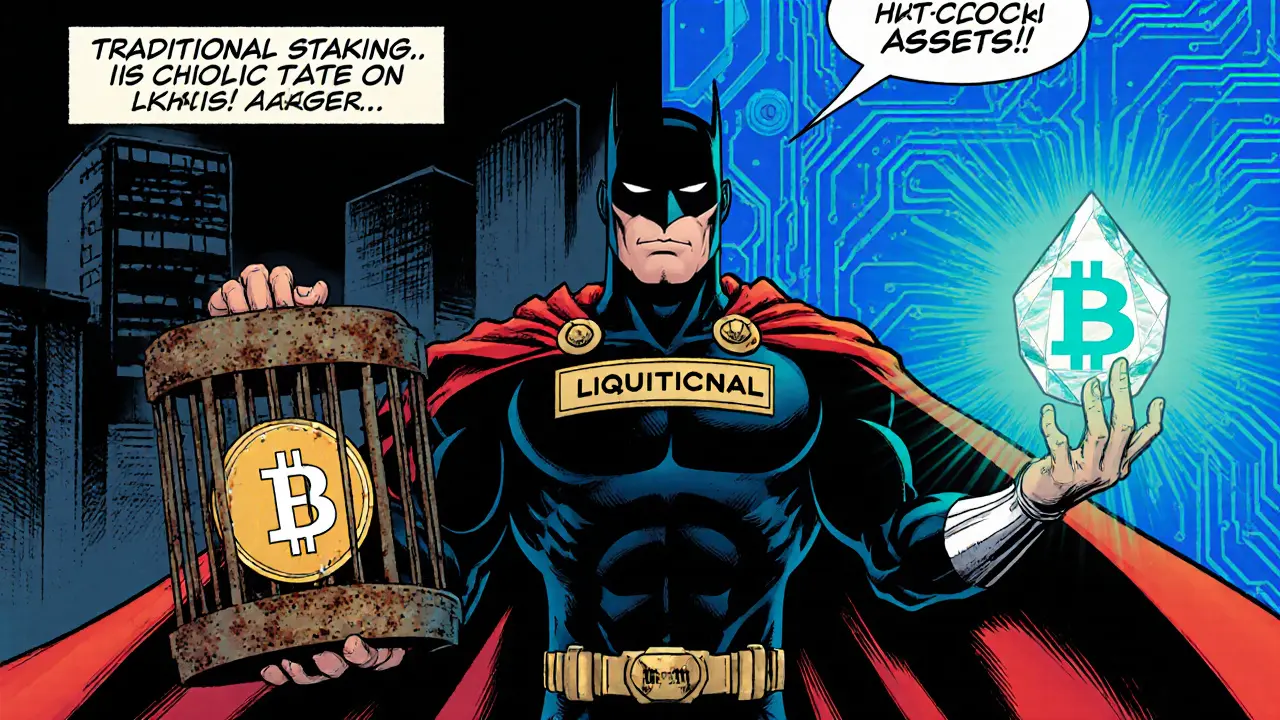Liquid Staking Return Calculator
Calculate Your Liquid Staking Returns
See how much more you can earn by using liquid staking instead of traditional staking. Based on real-world data from the article.
Key Takeaways
- Liquid staking unlocks the value of staked assets, letting you earn rewards and still use the tokens in DeFi.
- It removes the 7‑21 day unstaking wait that traditional staking imposes.
- Users can boost overall returns by 30‑40% through composability with lending, AMMs, and collateral.
- Risks include smart‑contract bugs, de‑pegging of liquid staking tokens, and centralization pressure.
- Choosing a protocol involves checking fees, custody model, TVL, and community support.
When you hear Liquid Staking is a mechanism that lets crypto holders lock up assets for network security while receiving a tradable token that represents the staked amount, you instantly get liquidity that traditional staking can’t match. In this guide we’ll walk through why liquid staking is gaining traction, how it works, and what you should watch out for before moving your coins.
What is Liquid Staking?
Liquid Staking allows users to delegate their tokens to validators via a smart contract, which then issues a derivative token - often called a liquid staking token (LST) - that tracks the original asset plus earned rewards. The first major deployments appeared on Ethereum 2.0 after the Beacon Chain launch in December2020. Major platforms like Lido Finance, Rocket Pool, and Stader Labs now support multiple chains, giving users a one‑click entry point.
Traditional Staking in a Nutshell
Traditional Staking requires locking the native token in a validator or staking pool for a fixed period, during which the funds cannot be transferred or used elsewhere. On Ethereum, the post‑Shanghai unstaking window dropped to about 21days, while networks like Solana or Polkadot impose similar waiting periods. This lock‑up creates an opportunity cost: you miss out on parallel DeFi yields while your assets sit idle.

How Liquid Staking Works - Step by Step
- Deposit your token (e.g., ETH) into the protocol’s smart contract.
- The contract stakes the deposit on your behalf with a validator set.
- You receive an LST (e.g., stETH for Lido, rETH for Rocket Pool) at a 1:1 ratio.
- The LST appreciates as staking rewards accrue, automatically reflecting the base asset plus earnings.
- You can trade, lend, or supply the LST in any DeFi protocol that accepts it.
- When you want to exit, burn the LST for the underlying token (subject to the protocol’s withdrawal queue).
This flow keeps your capital active, letting you capture multiple yield streams simultaneously.
Liquid Staking vs. Traditional Staking - A Direct Comparison
| Feature | Traditional Staking | Liquid Staking |
|---|---|---|
| Asset Liquidity | Locked for 7‑21days | Immediate via LST |
| Minimum Stake | Usually high (e.g., 32ETH) | As low as 0.01ETH (Lido, Rocket Pool) |
| Yield Sources | Only staking rewards (3‑5%APY on ETH) | Staking+DeFi yield (5‑15%APY on Aave, Uniswap fees) |
| Fees | Network fee only | 5‑14.5% of rewards (Lido 10%, Rocket Pool 14.5%) |
| Risk Profile | Validator slashing risk only | Smart‑contract risk, de‑pegging risk, centralization risk |
| Composability | None | Can be used as collateral, liquidity provision, yield farming |
Numbers from a Coinbase September2023 analysis show liquid staking can cut opportunity cost by roughly 35% because you earn on two fronts at once.
Real‑World Benefits You Can Feel
1. Higher Capital Efficiency - Aave’s lending pool paid about 8%APY on stETH in Q32023, meaning a user who locked 10ETH in Lido and supplied the resulting stETH to Aave earned roughly 4% from staking plus 4% from lending. That’s a 2‑fold boost compared to solo staking.
2. Flexibility for DAO Treasuries - Aave DAO allocated 10,000ETH to Lido in Q22023, instantly turning that into tradable stETH that could be sold or used as collateral without waiting for the 21‑day exit queue.
3. Access to AMM Liquidity - Uniswap’s ETH/stETH pool topped $280million TVL in August2023, letting liquidity providers earn fees while still holding a token that tracks ETH’s price.
4. Collateral for Stablecoins - MakerDAO accepted stETH as collateral in June2022, supporting $1.2billion of DAI creation by September2023.
These examples illustrate why many DeFi‑savvy users favor liquid staking: you don’t have to choose between security (staking rewards) and growth (DeFi yields).
Risks and Trade‑offs You Should Weigh
Smart‑Contract Risk means a bug or exploit in the staking protocol could freeze or steal your funds. Audits from firms like ConsenSys and OpenZeppelin help, but they’re not a guarantee.
De‑pegging Risk occurs when the LST trades at a discount or premium to the underlying asset. During the FTX crash, stETH slipped to a 6.2% discount, wiping out weeks of staking rewards in a single day.
Centralization Concern stems from the fact that a few providers (Lido, Rocket Pool, Stader) control most of the TVL, potentially creating a single point of failure for the network. Berkeley’s September2023 study flagged that the top three liquid staking services held 89.3% of Ethereum’s LST market.
Finally, tax treatment can get messy. Koinly’s 2023 guide notes that every time you supply an LST to a lending protocol you create a taxable event, requiring detailed record‑keeping.

How to Pick the Right Liquid Staking Protocol
Use this quick checklist:
- **Fees:** Lower fee structures (3‑5% of rewards) let you keep more of the upside.
- **Audit Track Record:** Look for multiple independent audits and a history of bug‑free upgrades.
- **Decentralization:** Preference for protocols that spread validator power (e.g., Rocket Pool’s minipools).
- **Liquidity Depth:** Higher TVL usually means tighter spreads and less slippage when swapping LSTs.
- **Community Support:** Active Discord/Telegram channels can speed up issue resolution.
For beginners, Lido’s low deposit threshold (0.01ETH) and extensive docs (4.7/5 rating on CryptoUser) make it a safe entry point. Advanced users who want more decentralization might lean toward Rocket Pool, which allows you to run your own mini‑validator.
Future Outlook - Where Is Liquid Staking Headed?
Ethereum’s Dencun upgrade in March2024 cut gas for LST transactions by roughly 12%, making frequent swaps cheaper. Protocol roadmaps show cross‑chain LSTs arriving in 2025, letting you stake ETH on one chain and use the derivative on another. Analyst forecasts from Gartner (Oct2023) predict liquid staking will capture 55‑65% of all PoS staking by 2026, provided centralization concerns are addressed. Restaking on EigenLayer already adds a new layer of yield: you can lock stETH into EigenLayer for extra rewards, though that adds another smart‑contract risk layer. In short, the space is maturing fast. Expect lower fees, more decentralized validator sets, and broader asset coverage (e.g., Solana, Polygon) as the next wave of protocols launches.
Next Steps for Readers
If you’re ready to experiment, follow this simple flow:
- Choose a wallet that supports the target chain (MetaMask for Ethereum, Phantom for Solana).
- Buy a small amount of the base token (e.g., 0.1ETH) to test the waters.
- Visit the chosen protocol’s UI (Lido, Rocket Pool, Stader) and deposit the token.
- Receive the LST in your wallet and verify the balance on a block explorer.
- Connect the wallet to a DeFi app like Aave or Uniswap and supply or trade the LST.
- Monitor the token’s price relative to the underlying asset and set alerts for large discounts.
Keep a spreadsheet of fees, yields, and any tax events. That record will help you compare liquid staking outcomes against pure staking over time.
Frequently Asked Questions
Can I unstake my tokens instantly with liquid staking?
You can swap or sell the liquid staking token at any time, but converting it back to the original asset may still involve a withdrawal queue, depending on the protocol’s design.
Do liquid staking tokens earn the same rewards as native staking?
Yes, the derivative token’s value is designed to track the underlying asset plus its staking rewards, minus protocol fees.
Is liquid staking safe for my funds?
Safety depends on the protocol’s audit history, validator distribution, and smart‑contract risk. Always diversify across multiple providers if you can.
What are the tax implications of using liquid staking?
Each time you earn staking rewards or receive DeFi yield, a taxable event occurs. Supplying an LST as collateral can also trigger income recognition. Use a crypto‑tax tool to track each step.
Which liquid staking protocol should I start with?
For beginners, Lido offers low minimum deposits and user‑friendly docs. More experienced users who value decentralization may prefer Rocket Pool’s minipool model or Stader’s cross‑chain options.


Jordan Collins
October 15, 2025 AT 09:12Liquid staking offers flexibility that traditional staking lacks. By tokenizing staked assets, users can maintain exposure to validator rewards while simultaneously deploying the same tokens in DeFi protocols. This composability enables extra yield streams such as lending, borrowing, and liquidity provision. Moreover, the ability to withdraw or transfer staked assets without unbonding periods reduces opportunity cost during volatile market moves.
Andrew Mc Adam
October 18, 2025 AT 17:12Yo, the biggest win with liquid staking is that you dont have to sit on your ass waiting 21 days to claim your ETH. You can keep earning staking returns and still farm high‑APR yields on the same capital. The LST tokens act like a passport into the rest of DeFi, no more locked‑up drama! Sure, fees exist, but the extra comps more than offset them in most cases.
Shrey Mishra
October 22, 2025 AT 01:12While the article extols the virtues of liquid staking, it glosses over the inherent risk of smart contract exposure. Users must trust that the underlying protocol will safeguard their staked ETH, a trust that is not trivial. Furthermore, fee structures can erode the theoretical 30‑40% boost, especially during periods of low network activity.
Ken Lumberg
October 25, 2025 AT 09:12Any system that incentivizes users to chase higher yields at the expense of security is morally questionable. Traditional staking may be conservative, but it respects the principle of minimal risk for a predictable reward. The hype around liquid staking often masks the temptation to over‑leverage, which can destabilize the network.
Blue Delight Consultant
October 28, 2025 AT 17:12Consider the philosophical angle: liquid staking transforms a passive act of securing a blockchain into an active participation in financial ecosystems. This metamorphosis blurs the line between validator duty and speculative play, raising existential questions about the purpose of staking itself. Yet, the trade‑off between autonomy and responsibility remains nuanced.
Wayne Sternberger
November 1, 2025 AT 01:12The practical benefit of liquid staking lies in its ability to keep capital productive. By delegating ETH to a protocol like Lido, you receive stETH which can be used as collateral on lending platforms. This dual‑use strategy respects both network security and individual financial goals without unnecessary interruption.
Gautam Negi
November 4, 2025 AT 09:12Contrary to popular belief, liquid staking is not a universal panacea. In markets where DeFi yields evaporate, the additional layer simply adds complexity and potential failure points. Users should evaluate whether the marginal upside truly justifies the extra on‑chain risk.
Shauna Maher
November 7, 2025 AT 17:12All that hype is just a scam.
Kyla MacLaren
November 11, 2025 AT 01:12I think liquid staking is a solid middle ground. It lets you keep earning validator rewards while still having the option to participate in other opportunities. Just make sure you read the fee schedule and understand the liquidity constraints of each token.
Linda Campbell
November 14, 2025 AT 09:12From a national perspective, the adoption of liquid staking should be encouraged to keep our domestic crypto infrastructure competitive on the global stage. The increased capital efficiency directly contributes to economic growth.
John Beaver
November 17, 2025 AT 17:12Liquid staking fundamentally changes the capital efficiency equation for Ethereum holders. First, when you stake ETH with a protocol like Lido, you receive a tokenized representation, typically stETH, that mirrors the value of the underlying asset plus accrued rewards. Second, that stETH can be deployed across a variety of DeFi applications, such as lending platforms, automated market makers, and yield farms, effectively stacking additional yield on top of the base staking reward.
Third, because the token is tradable, you retain the ability to liquidate or transfer your position without waiting for the standard 21‑day unbonding period, which is especially valuable during market volatility. Fourth, the composability of these tokens enables sophisticated strategies like using stETH as collateral to borrow other assets, then re‑investing those assets into high‑APY protocols, thereby amplifying returns.
Fifth, while protocol fees (e.g., Lido's 10% on rewards) do reduce the net gain, the overall boost can still outpace traditional staking by 30‑40% when DeFi yields are healthy. Sixth, the risk profile changes: you now face smart‑contract risk and potential token price deviation from ETH, which must be weighed against the higher upside.
Seventh, diversification across multiple liquid staking providers can mitigate single‑protocol risk, distributing exposure among Lido, Rocket Pool, and others. Eighth, through governance participation, token holders can influence protocol parameters, aligning incentives with the community.
Ninth, the regulatory landscape remains uncertain, and users should stay informed about jurisdictional compliance. Tenth, liquid staking also supports the broader Ethereum ecosystem by encouraging more validators to join, improving network security.
Overall, the decision to adopt liquid staking should be based on a clear assessment of fee structures, DeFi yield opportunities, and personal risk tolerance. By thoughtfully integrating these assets, you can achieve a more dynamic and rewarding staking experience.
EDMOND FAILL
November 21, 2025 AT 01:12Honestly, liquid staking just feels like the natural evolution for anyone who wants their ETH to keep working while they chill. No more staring at a locked‑up balance for weeks.
Jennifer Bursey
November 24, 2025 AT 09:12From a technical standpoint, the tokenization of staked ETH via LSTs introduces a novel vector for liquidity provisioning and risk management across DeFi primitives. The interoperability afforded by ERC‑20 compliance enables seamless integration with yield aggregators, which can auto‑optimize exposure based on real‑time APRs. In essence, this creates a composable layer that abstracts away the friction of traditional staking while preserving network security incentives.
Maureen Ruiz-Sundstrom
November 27, 2025 AT 17:12While the jargon‑heavy description sounds impressive, it ultimately masks the fact that users are being sold a complex financial product with hidden systemic risks. The supposed "optimizations" often lead to over‑leverage, and the average participant may not fully comprehend the cascade effects of a protocol failure.
Kevin Duffy
December 1, 2025 AT 01:12Great breakdown, John! 🙌 This really helps visualize how the extra yield stacks up. I'm definitely going to explore using stETH as collateral on a lending platform. 🚀